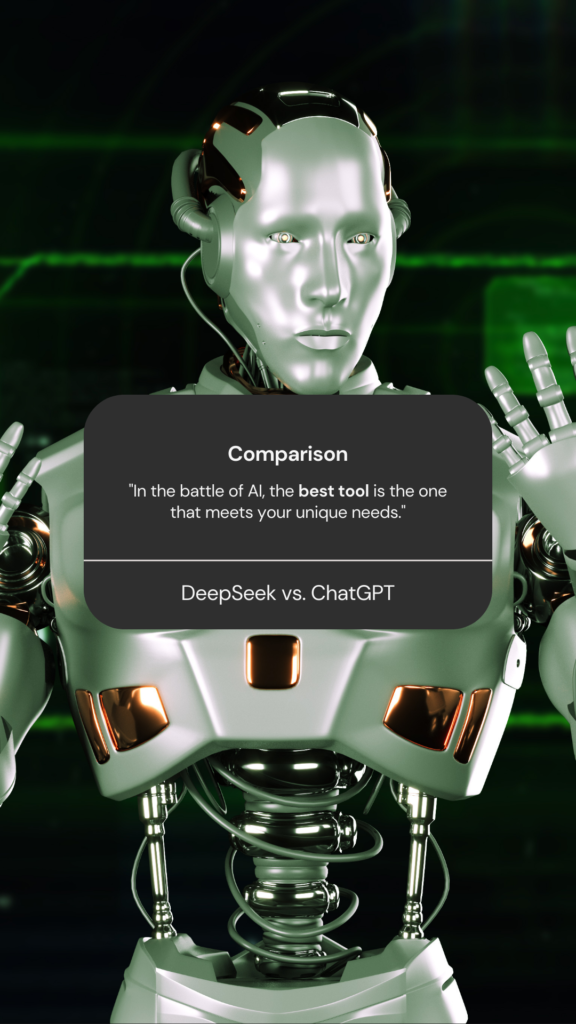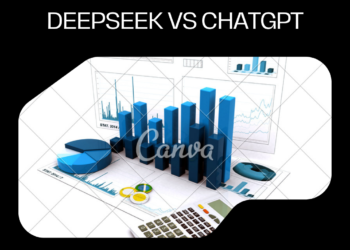Explore the key differences between DeepSeek and ChatGPT, including technical specs, use cases, performance, and ethical considerations. Discover which AI suits your needs.”In the battle of AI, “
Introduction
The rapid evolution of AI language models has transformed industries, from customer service to creative writing. Two notable players, DeepSeek and ChatGPT, have emerged with distinct approaches. While ChatGPT, developed by OpenAI, is a household name, DeepSeek, a Chinese AI pioneer, is gaining traction for its specialized focus. This 4000-word guide dives deep into their differences, strengths, and ideal applications, helping you choose the right tool for your needs.
Background and Development

What is ChatGPT?
- Developer: OpenAI, a U.S.-based research lab founded in 2015.
- Key Milestones:
- GPT-3 (2020): 175B parameters, multilingual support.
- GPT-4 (2023): Improved reasoning, multimodal capabilities (text + images).
- Mission: Ensure AGI (Artificial General Intelligence) benefits all humanity.
What is DeepSeek?
- Developer: DeepSeek AI, a Chinese company focused on AGI since its inception.
- Key Models:
- DeepSeek-R1: Optimized for real-time interactions.
- DeepSeek Chat: Tailored for Chinese language and culture.
- Mission: Advance AGI with an emphasis on enterprise solutions and localized applications.

Key Difference: While both aim for AGI, ChatGPT targets global multilingual use, whereas DeepSeek open for market needs.
Technical Architecture
ChatGPT’s Framework
- Base Architecture: Transformer-based, leveraging attention mechanisms.
- Training Method: Supervised learning + Reinforcement Learning from Human Feedback (RLHF).
- Scalability: GPT-4’s sparse expert models reduce computational costs.
DeepSeek’s Innovation
- Hybrid Architecture: Combines transformers with proprietary algorithms for efficiency.
- Dynamic Learning: Adapts to user behavior in real-time (e.g., DeepSeek-R1).
- Resource Efficiency: Claims 50% lower inference costs than comparable models.
Comparison Table:
| Feature | ChatGPT | DeepSeek |
|---|---|---|
| Architecture | Transformer | Hybrid |
| Training Method | RLHF | Dynamic Learning |
| Cost Efficiency | Moderate | High |
Training Data and Cultural Nuance
ChatGPT’s Data Strategy
- Sources: Books, websites, scientific papers (pre-2023 data for GPT-4).
- Multilingual Support: 50+ languages but strongest in English.
- Cultural Bias: Reflects Western perspectives, with ongoing moderation.
DeepSeek’s Localized Focus
- Chinese-Centric Data: Trained on Mandarin content, idioms, and regional dialects.
- Enterprise Integration: Customizable for industries like finance and e-commerce in China.
- Regulatory Compliance: Adheres to Chinese data laws (e.g., GDPR-like regulations).
Use Case Example:
- ChatGPT: A global user asks for pizza recipe ideas.
- DeepSeek: A Chinese user inquires about regional festival traditions.
Performance and Capabilities
Accuracy and Speed
- ChatGPT:
- Excels in creative tasks (e.g., storytelling, code generation).
- May lag in real-time applications due to latency.
- DeepSeek:
- Faster response times (optimized for enterprise workflows).
- Superior in Chinese-language technical queries.
Contextual Understanding
- ChatGPT: Handles long dialogues but may lose coherence in extended conversations.
- DeepSeek: Uses context-aware algorithms for consistent interactions (e.g., customer support chats).
Benchmark Highlight:
- In a Chinese financial Q&A test, DeepSeek achieved 92% accuracy vs. ChatGPT’s 78%.

Use Cases and Applications
ChatGPT’s Versatility
- Content Creation: Blogs, marketing copy, social media.
- Education: Tutoring, language learning.
- Programming: Debugging, code snippets.
DeepSeek’s Specialization
- Enterprise Solutions: CRM automation, data analysis.
- Localized Services: Legal document drafting in Chinese, e-commerce chatbots.
- Research: AGI-focused projects with academic partners.
Industry Adoption:
- ChatGPT: Used by Duolingo, Microsoft, and startups worldwide.
- DeepSeek: Partnered with Alibaba Cloud, Tencent, and Chinese universities.
Ethical and Privacy Considerations
ChatGPT’s Safeguards
- Content Moderation: Filters harmful requests per OpenAI’s policy.
- Data Privacy: User interactions anonymized; opt-out options.
DeepSeek’s Compliance
- Data Localization: Stores data within China as per regulations.
- Ethical AI Framework: Aligns with Chinese governance standards.
Controversy Note: ChatGPT faced bans in Italy over privacy concerns; DeepSeek avoids similar issues via strict compliance.
Future Roadmap
ChatGPT’s Goals
- Multimodal Expansion: Integrate voice, video, and AR.
- Reduced Bias: Enhance cultural inclusivity in responses.
DeepSeek’s Vision
Global Expansion: Target Southeast Asian and Middle Eastern markets.
AGI Leadership: Pioneer ethical, human-aligned AGI.
FAQ Section
Q1: Which is better for non-English tasks?
A: DeepSeek excels in Chinese; ChatGPT supports multiple languages but performs best in English.
Q2: Can DeepSeek replace ChatGPT?
A: For Chinese enterprises, yes. Globally, ChatGPT remains more versatile.
Q3: How do costs compare?
A: DeepSeek offers lower inference costs, but ChatGPT’s API is more accessible globally.
Conclusion
Choosing between DeepSeek and ChatGPT hinges on your needs:
- Global, Multilingual Tasks: ChatGPT.
- Chinese-Language Expertise: DeepSeek.
Both models push AGI boundaries, but their specialized focuses cater to different audiences. Stay informed as they evolve to leverage their full potential.























